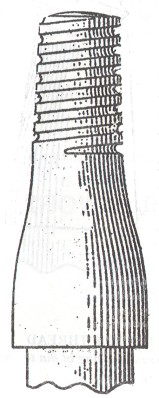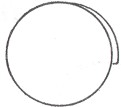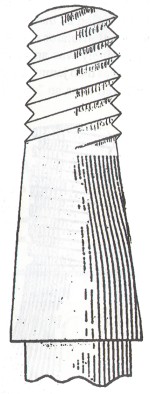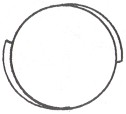The Double Threaded Insulator
by Eric Halpin
Reprinted from "Crown Jewels of the Wire", July 1991, page 19
The development of threaded pinhole insulators is a history of both man's
technological tribulations and ingenuity. In the same manner that the actual
electromagnetic telegraph and its operating apparatus was continually upgraded
and refined, so was the parallel development of an essential component: The
perfect insulated wire securing device.
The earliest form of insulators (1844)
were comprised of glass plates surround a shellac-laden cloth holding a wire
within a notched crossarm. By 1845 a glass insulator similar in shape to a
bureau knob was used with unsatisfactory results. In 1846 a center notched glass
block was being used in a rapidly expanding telegraph industry. The next
major development was the concept of suspending the wire using an insulated iron
hook. By 1850 industry requirements for a more successful insulator resulted in
continual new styles and wire securing concepts, most notably was an insulator
with a smooth cylindrical and tapered pin hole which was then jammed onto a
compatible wooden peg. The earliest of this design is referred to as an
"egg" insulator, and there were many other threadless styles soon to
follow.
But without question, the greatest developmental concept for
a insulator was in 1865 when an internal screw thread was patented by Louis
Cauvet. Since 1870, mass production of threaded pinhole insulators began and the
industry never looked back. Despite the probable costs of insulator
manufacturing companies buying in for the rights to use this patented threading
concept, they had little choice as it was obvious to all that it was the only
proper road to follow.
|

|

|
Drawing #1. THE STANDARD ACME THREAD
One continuous thread starting at pin
top, and sloping at a 10 degree angle. |
In Canada, one of the earliest threaded styles is a telegraph insulator known
in the hobby as the CD 143. Of the many sub-varieties in this style, there is an
insulator that is truly unique within the world of insulators, the double-threaded insulator.
In North America, the standard for general utility
or "acme" threads such as those found on insulators, is four threads
to the inch. This thread is formed by one continuous ridge starting at the top
of the mandrel and pinhole crown and winding down towards the base at a 10
degree helix angle (Drawing 1.) The "acme" thread is sometimes called
a "knuckle" thread. Some of the earliest forms of "acme"
threads were actually made in a "V" or sawtooth -- shape up until 1880
or so. The machined mandrel with the threads and the resultant pinhole is always
tapered so that the threads fit into each other by compression or interference.
A true cylindrical mandrel and pinhole would result in no compression contact
until the pin reached the top of the insulator and this could lead to a crown
stress fracture.
The doubled threaded insulator also has four threads to the
inch but instead of one continuous ridge it has two. This is called a multiple
start thread. The double ridge is achieved by starting each ridge 180 degrees
opposite each other and winding each ridge down the mandrel and thus the
pinhole. Because both ridges must fit within the same given area, the
"angle of the helix" must be double that of the standard helix or 20
degrees (Drawing #2). When a double threaded insulator is screwed into a
standard pin, it will still hold tight but will cross thread on the first
turn.
It is not known why or who came up with the idea of double
threading insulators but there are some advantages as follows. First and
foremost is that the lineman can screw the insulator onto the pin twice as
quickly since with each revolution the insulator moves down twice as far on the
pin. The second advantage is since there is twice the thread surface, if follows
that there is greater compression or interference contact with each thread and
thus increasing the holding power.
|

|

|
Drawing #2. THE DOUBLE THREAD
Two continuous threads starting at pin top and
sloping at a 20 degree angle. |
If the double threaded ideas was so good, why didn't it catch on within the
industry? I suspect that the double thread may have been an attempt to
circumvent the original Cauvet patent to eliminate any remuneration costs. If
the double thread was challenged as a patent infringement it would likely have
succeeded. It is also very likely that the North American telegraph industry
recognized the need for standard of construction, maintenance and operation.
Regardless of how or why this double threaded insulator came into being,
there can be no doubt about how unique this insulator pinhole is!
So far, I have identified that there were three different molds used to
manufacture this scarce and highly desirable variety of CD 143. The differences
are very slight and observable only after extremely detailed examination. All
are two piece molds (MLOD), have "V" threads and were subject to a
wide level of glass pour resulting in height differences of up to 3/4", but
of further great interest to collectors is the spectacular colors that can be
found in the double threaded variety as follows:
Aquas: pale to dark and tones of blue and green
Greens: light to medium and tones of olive and yellow
Blues: light to medium and tones of steel, cornflower and gray
Yellow: light to medium and tones of green and amber
The existence of this unique family of double threaded insulators would
likely have not become known if it wasn't for the very keen and observant eye of
Grant Salzman. Mr. Salzman gave to the world of insulator collectors the
knowledge of this insulator in a November, 1981 Crown Jewels of the Wire
article entitled "Me and the 143".
| 